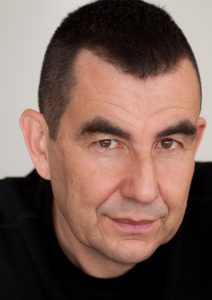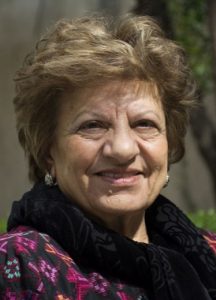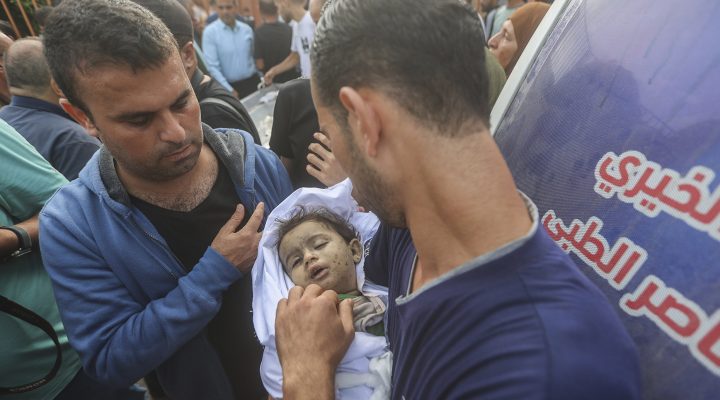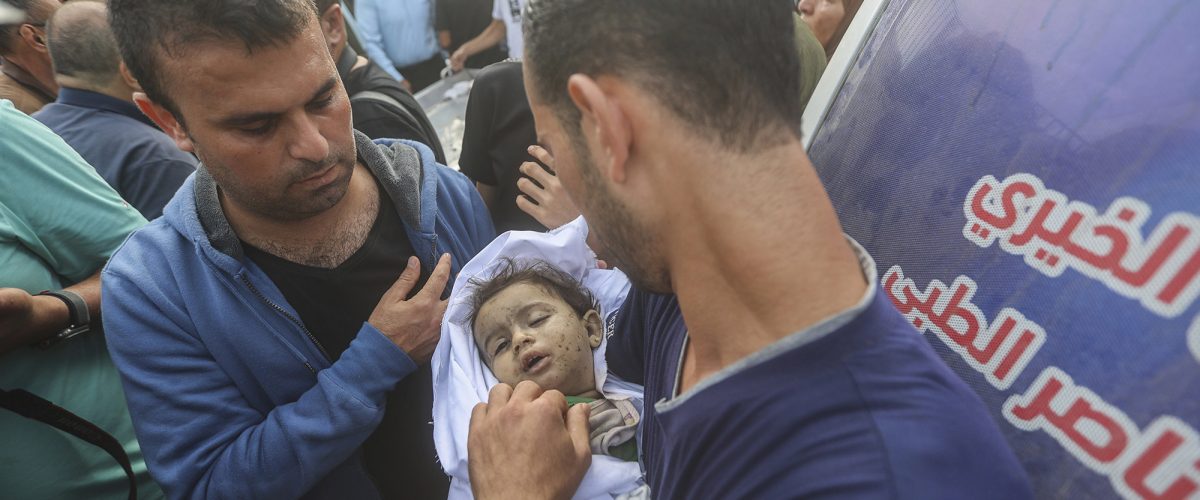The news stories of what has been happening in Israel and Gaza since Oct. 7 have been difficult to absorb. The horrific loss of life, utter destruction of neighborhoods and the terrifying abduction of civilians of all ages have seemed unbelievable.
Since reports from Vietnam more than 50 years ago, we have been able to experience the sights and sounds of battle right in our own living rooms. There were, indeed, visual moments that took our breath away.

Robert Sellers
We may never forget the photo of Phan Thi Kim Phuc, the naked and burned 9-year-old Vietnamese girl fleeing a napalm attack on Trang Bang village in 1972. The photo, nicknamed “Napalm Girl,” may not have helped to lead to the end of the conflict, but it certainly impacted American public opinion.
Now wartime brutality has become more appalling and the televised reports of it more graphic. Presentations today can be so stark and sadistic that photos are often blurred or preceded by a warning that what will be shown is disturbing. Sarah Parkinson, assistant professor of political science and international studies at Johns Hopkins University, explains:
The repeated posting of graphic images can lead to desensitization and dehumanization, where people become numb to what they are watching, (and) stop seeing victims as individuals who have lives and families and stop caring. … Many people who live this violence every day, or who have lived it in the past, stay offline during times like these given how traumatizing viewing these images can be.
The news of butchered babies and child corpses discovered in Israeli kibbutz communities after the attack by Hamas is shocking. The Times of Israel says 1,400 people, mostly civilians, were killed and hundreds more kidnapped and injured in the Oct. 7 violence.
Disturbing, also, are pictures of the aftermath of Israeli bombs in Gaza where, according to Aljazeera, the Defense for Children International in Gaza reports about 100 Palestinian children have been killed every day since Israel began its bombing on Oct. 7.
“Whether planned or not, the effects of war on the young are always tragic.”
While it is evident that the death of children in Israeli kibbutz communities was intentional, it is also clear that the suffering of children in Gaza tenements was not intended. Yet, whether planned or not, the effects of war on the young are always tragic. When we see the small body bags being collected in Kibbutz Kfar Aza or witness sobbing Palestinian children or their parents on the rubble in Gaza City, our minds and hearts turn to our own children and grandchildren.

David Shipler
This is the seventh in a series of major Arab-Israeli wars since the establishment of the state of Israel in 1948. As The New York Times correspondent David Shipler writes in his 1986 book, Arab and Jew: Wounded Spirits in a Promised Land:
For both Jews and Arabs, war has produced its own sorrow and glorification. The Jews have confronted it mostly through combat, mourning their dead, nursing their wounded, extolling their heroes, praying for peace and victory. …
For many of the Palestinian Arabs who live, or once lived, between the Jordan and the Mediterranean, war has meant something else: displacement from their home villages. That has been their central experience of war. … A young lad from a West Bank refugee camp who goes off to join the (struggle) … stirs mixed feelings among his family and friends — a dread of loss to his parents in many cases, a heroic portrait among his peers.
While the Palestinian youth volunteers to fight for liberation from occupation, arrests, torture, killings, bulldozing of homes and confiscation of land, on the other side of the boundaries — and dividing wall — Israeli teenagers leave for their mandatory military service at age 18 or 19. They, too, are willing to serve the cause of liberation, but of a different kind: liberation from the chronic possibility of being overrun by Hamas or Hezbollah, the fear of suicide bombers, random shootings or deadly rockets, as well as the spread of the conflict to other Muslim countries surrounding isolated Israel.

Ari Shavit
Ari Shavit, a Jewish Israeli journalist for one of Israel’s leading newspapers, Haaretz, talks about living under the threat of personal demise and national destruction in his award-winning book, My Promised Land: The Triumph and Tragedy of Israel:
For as long as I can remember, I remember fear. Existential fear. The Israel I grew up in — the Israel of the mid-1960s — was energetic, exuberant and hopeful. But I always felt that beyond the well-to-do houses and upper-middle-class lawns of my hometown lay a dark ocean. One day, I dreaded, that dark ocean would rise and drown us all. A mythological tsunami would strike our shores and sweep my Israel away. It would become another Atlantis, lost in the depths of the sea.
One morning in June 1967, when I was 9 years old, I came upon my father shaving in the bathroom. I asked him if the Arabs were going to win. Would the Arabs conquer our Israel? Would they really throw us all into the sea? A few days later the Six Day War began. …
For as long as I can remember, I remember occupation. Only a week after I asked my father whether the Arab nations were going to conquer Israel, Israel conquered the Arab-populated regions of the West Bank and Gaza. A month later, my parents, my brother and I embarked on a first family tour of the occupied cities of Ramallah, Bethlehem and Hebron. Wherever we went, there were remains of burned Jordanian Jeeps, trucks and military vehicles. White flags of surrender hung over most houses. Some streets were blocked with the mangled, blackened carcasses of fancy Mercedes automobiles that had been run over by the treads of Israeli tanks. Palestinian children my age and younger had fear in their eyes. Their parents appeared devastated and humiliated. Within a few weeks, the mighty Arabs were transformed into victims, while the endangered Israelis became conquerors. …
So I became a peacenik. First as a young activist and then as a journalist, I fought occupation with a passion.

Jean Zaru
Jean Zaru is a Palestinian Christian peace activist who has lived under occupation in Ramallah since 1967. In her book, Occupied with Nonviolence: A Palestinian Woman Speaks, she says:
As a Palestinian, I am one of about 9 million Palestinians both inside and outside Palestine, struggling for justice and freedom for our homeland. Half of our Palestinian people have been uprooted and forcibly thrown out of their homes, some more than once, and the other half subjected to the rule of others in our own land. Yet, Palestinians are viewed primarily as “a problem” for many in Israel because they want the land without the people. From our standpoint, we are denied the right to self-determination and live under Israeli military occupation, which is the root cause of other forms of human rights violations against us. Many of my people have no guarantees of basic life necessities and no hope for the full development of their human potential. …
In the war of 1948, I was only 8 years old. Yet I can remember the fear very clearly. I remember hiding in the basement in our home. I remember the refugees coming to Ramallah from the coastal plain of Palestine. … Fifty of these people shared our house for a period of six weeks. Another 100 camped under our pine trees. … The war ended, but the plight of those refugees continues. …
By the time the war broke out again in 1967, our oldest son was 8 years old. His sister was 5. We were hiding in a shelter, which was partially damaged, and our very lives were threatened at every moment. As the bombs fell, our shelter became more and more precarious. Then we moved to another shelter, which we shared with 30 children and adults. That night, two little girls died from an Israeli air raid. Overnight, we found ourselves under the dominance of an occupying power.
Ari and Jean — he an Israeli and she a Palestinian — represent thousands on both sides of this conflict who have lived since childhood under intimidation and occupation. It is remarkable that each of them, despite their personal travail and the suffering of their own people, has grown up to become an advocate for peace and nonviolence.
That is because our natural human tendency is that when we suffer indignity, physical or emotional abuse, tremendous loss — even the loss of life of our loved ones — we want revenge. We desire retaliation. We hope for reprisal. We long for recompense and restoration.
This human reaction is reflected in Psalm 137, one of the most critiqued — and avoided — passages in the Bible. Here are verses 1-9:
By the rivers of Babylon, there we sat and we wept as we remembered Zion. On the poplars within her we hung our lyres, for it was there our captors asked us for words of song, and our tormentors — for their amusement — said, “Sing for us from a song of Zion.” How can we sing a song of the Lord on foreign soil? O Jerusalem, if I should forget you may my right hand wither. May my tongue cleave to my palate if I cease to remember you, if I do not cause Jerusalem to be raised to the very top of my joy. Do you remember, O Lord, the Edomites on the day of Jerusalem? How they said, “Tear her down! Down to her very foundation!” O, Daughter of Babylon, you despoiler, Happy is the one who pays you your recompense as you dealt out to us. Happy the one who will seize and dash your infants against the rock!
Among many online discussions of this Psalm is a helpful one from HuffPost that quotes three scholars — one from Hebrew College, a pluralistic rabbinic seminary, and the other two from Lancaster Theological Seminary, a United Church of Christ graduate school — who explain the meaning of this text.
Joel Baron, a fifth-year student at Hebrew College, writes:
This plaintive Psalm recalls the Babylonian exile and the mournful refrains, not of the people Israel, but of the (psalmists) themselves, who in their misery and their distance from Jerusalem could no longer make music. All they could think of was return, and, surprisingly, revenge.
Greg Carey, a New Testament professor at Lancaster, adds:
There’s no need to “explain away” these verses. The Psalms, perhaps to a unique degree within Scripture, are true to life. They express the full range of human emotion and bring that emotion into the presence of God. … No one, I think, would argue that slaughtering babies is an appropriate answer to injustice. But many people know the bitterness that could lead to such sentiments.
And Julia O’Brien, an Old Testament professor, also at Lancaster, concludes:
Historically, interpreters disturbed by passages like this have tried to “fix” them. … Rather than assume that every biblical statement provides instruction for how to think and live, I read the Bible as ancient people’s testimony to God and as an invitation to speak honestly about our own experience. … Perhaps Psalm 137 can invite us to bring all of ourselves to our faith — not just our best selves — and remind us to pay more attention to the voices of those whom we have caused pain.
Whether the image of dashing babies against the rock is interpreted as metaphorical language that is not referring to killing babies at all, as a powerful imprecatory prayer that calls down divine judgment upon one’s enemies, as a notorious, immoral wish for revenge — even the annihilation of the young — or as a reminder that the sufferer must rely upon God for restitution, it is clear the image of killing children is absolutely contrary to the teachings of the sacred Scriptures the various actors in this current conflict claim to follow.
Islam teaches Muslims to regard children as gifts from Allah. The Quran and the Sunnah obligate parents to protect the rights of children, including food, shelter and health care. The young have the right to protected life, beginning before birth and continuing throughout childhood.
Judaism teaches the care of others, including children, for each person is created in God’s image and is valuable. Children, insists the Torah, are a gift from God and they should be cherished, guided and protected. The ancient instruction that parents should administer corporal punishment to disobedient children has been revised and synagogues actively promote the welfare of the young.
Christianity teaches, in numerous New Testament passages, that adults must never despise little ones, nor provoke them lest they become discouraged. Special judgment will condemn those who cause a child to stumble or sin.
“Pure and undefiled religion before God requires that fatherless children be cared for and loved.”
Pure and undefiled religion before God requires that fatherless children be cared for and loved. Jesus, the one whom Christians are to emulate, called children to himself and said anyone who receives a child in his name is receiving Christ himself and the one who sent him.
Returning to the implications of Professor O’Brien’s interpretation of Psalm 137:9, it is obvious from these teachings of the three Abrahamic religions that we should “pay more attention to the voices of those whom we have caused pain.” Sacred texts in the Quran, the Torah and the New Testament demand that we never forget the children’s voices. We must listen to informants like the Israeli Ari Shavit and the Palestinian Jean Zaru, both of whom felt fear and disorientation when they were young and have seen the same panicked looks on the faces of their own children and grandchildren.
Sometimes art touches us in a profound way and moves us deeply. That can be a photograph, like the Pulitzer Prize-winning “Napalm Girl.” But we also can be struck by a painting, sculpture, play, film, essay or song.
In 1972, the very same year the horrific image of the young Vietnamese girl fleeing violence made such an impression on me, a movie and its theme song touched my heart. Director Stanley Kramer’s Bless the Beasts and Children told the story of “six teenaged boys, each a misfit in one way or another, (who were) ostracized by the other boys at a summer camp but (formed) a bond among themselves. After seeing a herd of bison selected for culling by local hunters, they (resolved) to sneak away from the camp and set the penned bison free.”
Tragically, one of the boys is shot and killed by the hunters who are trying to stop his attempts to free the bison.
The themes in the movie are relevant to the condition of the young innocents in this current war between Israel and Hamas. Those on both sides of the conflict are guilty of harming and, either on purpose or unintentionally, even murdering children. Just like the endangered herd of bison — and the miserable boys in their frightful nightmares — both Israeli and Palestinian children must be rescued before they are “culled” by contrived or careless bullets or bombs.
The 1972 Oscar-nominated song of the same title, made famous by the Carpenters, has lyrics I have remembered for more than 50 years:
Bless the beasts and the children, for in this world they have no voice, they have no choice.
Bless the beasts and the children, for the world can never be the world they see.
Light their way when the darkness surrounds them; give them love, let it shine all around them.
Bless the beasts and the children; give them shelter from the storm; keep them safe; keep them warm.
Bless the beasts and the children; give them shelter from the storm; keep them safe; keep them warm.
Rob Sellers is professor of theology and missions emeritus at Hardin-Simmons University’s Logsdon Seminary in Abilene, Texas. He is a past chair of the board of the Parliament of the World’s Religions in Chicago. He and his wife, Janie, served a quarter century as missionary teachers in Indonesia. They have two children and five grandchildren.


